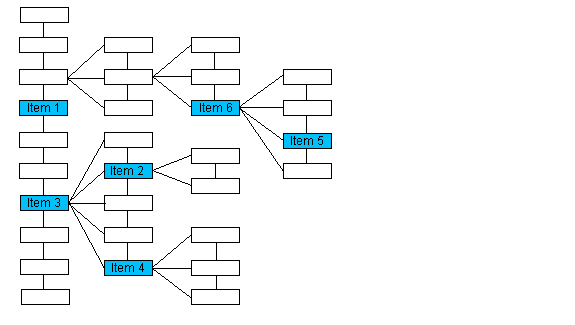←Select platform
In This Topic ▼
GetParentKey Method
Summary
Returns the item in the Dicom Dir Data Set that contains the parent of the specified item.
Syntax
C#
Objective-C
C++/CLI
Java
public DicomElement GetParentKey(DicomElement element)
- (nullable LTDicomElement *)parentKey:(LTDicomElement *)element; public DicomElement getParentKey(DicomElement element) public:DicomElement^ GetParentKey(DicomElement^ element)
Parameters
element
An item in the Data Set.
Return Value
The item in the Data Set that is the parent of the item specified by element, or a null reference (Nothing in VB) if element has no parent (element is a Level 0 item).
Remarks
The parent is the ancestor one level higher than the specified item. If the specified item is a Level 0 item, this method will return a null reference (Nothing in VB). Please note that the numbering of the items in the following illustration is arbitrary and does not imply order.

| If the passed object points to: | The method returns an object pointing to: |
|---|---|
| Item 1 | null |
| Item 2 | Item 3 |
| Item 4 | Item 3 |
| Item 5 | Item 6 |
The following methods will also help you navigate the Data Set:
Example
C#
using Leadtools;using Leadtools.Dicom;public void DicomDIRSample(){//Make sure to initialize the DICOM engine, this needs to be done only onceDicomEngine.Startup();using (DicomDataSet dicomDIR = new DicomDataSet()){dicomDIR.Reset();//Initialize the dataset as a DICOMDIR classdicomDIR.Initialize(DicomClassType.BasicDirectory, DicomDataSetInitializeType.ExplicitVRLittleEndian);Debug.Assert(dicomDIR.InformationClass == DicomClassType.BasicDirectory);Debug.Assert(dicomDIR.InformationFlags == (DicomDataSetFlags.ExplicitVR | DicomDataSetFlags.LittleEndian | DicomDataSetFlags.MetaHeaderPresent));//Insert a patient level keyDicomElement patientKey = dicomDIR.InsertKey(null, DicomDirKeyType.Patient, true);//Insert a study key under the patient keyDicomElement studyKey = dicomDIR.InsertKey(patientKey, DicomDirKeyType.Study, true);//Now insert three series keys under the study keyDicomElement seriesKey = dicomDIR.InsertKey(studyKey, DicomDirKeyType.Series, true);seriesKey = dicomDIR.InsertKey(studyKey, DicomDirKeyType.Series, true);seriesKey = dicomDIR.InsertKey(studyKey, DicomDirKeyType.Series, true);DicomElement key = dicomDIR.GetRootKey(seriesKey);//Get the key value, You can also call GetKeyValuePtrDicomDirKeyType keyValue = dicomDIR.GetKeyValue(key);//The root key for the series key should be patientDebug.Assert(keyValue == DicomDirKeyType.Patient, "The root key for the series key should be patient in this case");//Get the parent key for the series, it should be studykey = dicomDIR.GetParentKey(seriesKey);keyValue = dicomDIR.GetKeyValue(key);Debug.Assert(keyValue == DicomDirKeyType.Study, "The parent key for the series key should be study in this case");//The child for the study key should be serieskey = dicomDIR.GetChildKey(studyKey);keyValue = dicomDIR.GetKeyValue(key);Debug.Assert(keyValue == DicomDirKeyType.Series, "The child for the study key should be series");//The first key should be patient, if we traverse the DICOMDIR as a listkey = dicomDIR.GetFirstKey(studyKey, false);keyValue = dicomDIR.GetKeyValue(key);Debug.Assert(keyValue == DicomDirKeyType.Patient);//The last key should be series, if we traverse the DICOMDIR as a listkey = dicomDIR.GetLastKey(studyKey, false);keyValue = dicomDIR.GetKeyValue(key);Debug.Assert(keyValue == DicomDirKeyType.Series);//The key before the study key should be patient, if we traverse the DICOMDIR as a listkey = dicomDIR.GetPreviousKey(studyKey, false);keyValue = dicomDIR.GetKeyValue(key);Debug.Assert(keyValue == DicomDirKeyType.Patient);//The key after the study key should be series, if we traverse the DICOMDIR as a listkey = dicomDIR.GetNextKey(studyKey, false);keyValue = dicomDIR.GetKeyValue(key);Debug.Assert(keyValue == DicomDirKeyType.Series);//If we delete the study key, the series keys under it will get deleted toodicomDIR.DeleteKey(studyKey);key = dicomDIR.FindFirstKey(null, DicomDirKeyType.Series, false);Debug.Assert(key == null);key = dicomDIR.FindLastKey(null, DicomDirKeyType.Series, false);Debug.Assert(key == null);key = dicomDIR.FindPreviousKey(null, false);Debug.Assert(key == null);key = dicomDIR.FindNextKey(null, false);Debug.Assert(key == null);}DicomEngine.Shutdown();}
Requirements
See Also
Reference
Help Version 22.0.2023.1.29
Products | Support | Contact Us | Intellectual Property Notices © 1991-2023 LEAD Technologies, Inc. All Rights Reserved.
Leadtools.Dicom Assembly
